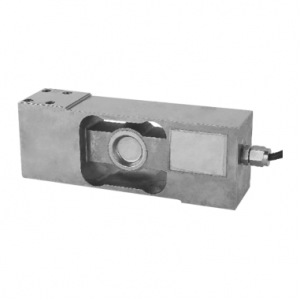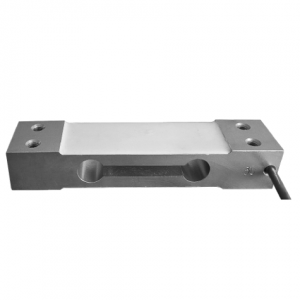- තාක්ෂණික පරාමිතීන් හඳුන්වා දීමට උප-අයිතම දර්ශක ක්රමය භාවිතා කරන්න.පැටවුම් කොටුව. සාම්ප්රදායික ක්රමය වන්නේ උප-අයිතම දර්ශකය භාවිතා කිරීමයි. වාසිය නම් භෞතික අර්ථය පැහැදිලි වන අතර එය වසර ගණනාවක් තිස්සේ භාවිතා කර ඇති අතර බොහෝ අය ඒ ගැන හුරුපුරුදු වීමයි. අපි දැන් එහි ප්රධාන අයිතම පහත පරිදි ලැයිස්තුගත කරමු: *ශ්රේණිගත ධාරිතා නිෂ්පාදකයා විසින් ලබා දී ඇති බර කිරිමේ පරාසයේ ඉහළ සීමාවේ අගය.
*ශ්රේණිගත ප්රතිදානය (සංවේදීතාව)
ශ්රේණිගත භාරය යොදන විට සහ බරක් නොමැති විට සංවේදකයේ ප්රතිදාන සංඥාව අතර වෙනස. බර සෛලයේ ප්රතිදාන සංඥාව යොදන ලද උද්දීපන වෝල්ටීයතාවයට සම්බන්ධ බැවින්, ශ්රේණිගත ප්රතිදානයේ ඒකකය mV/V වලින් ප්රකාශ වේ. එය සංවේදීතාව ලෙස හඳුන්වන්න.
*සංවේදීතා ඉවසීම
සංවේදකයේ සත්ය ස්ථායී ප්රතිදානය සහ අනුරූප නාමික ශ්රේණිගත ප්රතිදානය අතර නාමික ශ්රේණිගත ප්රතිදානය අතර වෙනසෙහි ප්රතිශතය. උදාහරණයක් ලෙස, බර සෛලයක සත්ය ශ්රේණිගත ප්රතිදානය 2.002mV/V වන අතර, අනුරූප සම්මත ශ්රේණිගත ප්රතිදානය 2mV/V වේ, එවිට එහි සංවේදීතා ඉවසීම: ((2.002–2.000)/2.000) *100%=0.1%
*Nරේඛීය
බරක් නොමැති ප්රතිදාන අගය සහ ශ්රේණිගත භාරයේදී ප්රතිදාන අගය සහ වැඩිවන භාරයේ මනින ලද වක්රය මගින් තීරණය කරන ලද සරල රේඛාව අතර උපරිම අපගමනය ශ්රේණිගත ප්රතිදාන අගයේ ප්රතිශතය වේ.
*පසුගාමීTඔලිරන්ස්
බරක් නොමැති බරකින් ශ්රේණිගත කළ බරකට ක්රමයෙන් පැටවීම සහ පසුව ක්රමයෙන් බාගැනීම. එකම බර ලක්ෂ්යයේදී ශ්රේණිගත කළ ප්රතිදාන අගයට පැටවීම සහ බෑම ප්රතිදානය අතර උපරිම වෙනසෙහි ප්රතිශතය.
*පුනරාවර්තන හැකියාවEබියකරු
එකම පාරිසරික තත්ත්වයන් යටතේ, සංවේදකය නැවත නැවතත් ශ්රේණිගත කළ භාරයට පටවා එය බාන්න. පැටවීමේ ක්රියාවලියේදී එකම පැටවුම් ලක්ෂ්යයේදී ප්රතිදාන අගයේ උපරිම වෙනසෙහි ප්රතිශතය ශ්රේණිගත කළ ප්රතිදානයට.
*Cරීප්
භාරය නියත වන විට (සාමාන්යයෙන් ශ්රේණිගත කළ භාරය ලෙස ගනු ලැබේ) සහ අනෙකුත් පරීක්ෂණ තත්වයන් නොවෙනස්ව පවතින විට, භාර සෛල ප්රතිදානයේ ප්රතිශතය කාලයත් සමඟ ශ්රේණිගත කළ ප්රතිදානයට වෙනස් වේ.
* ශුන්යOපිටතට
නිර්දේශිත වෝල්ටීයතා උද්දීපනය යටතේ, සංවේදකයේ ප්රතිදාන අගය යනු බරක් යොදන්නේ නැති විට ශ්රේණිගත ප්රතිදානයේ ප්රතිශතයයි.
*පරිවරණයRනොනැසී පැවතීම
සංවේදක පරිපථය සහ ඉලාස්ටෝමරය අතර DC ප්රතිරෝධක අගය.
*Iඑන්පුට්Rනොනැසී පැවතීම
සංඥා ප්රතිදාන පර්යන්තය විවෘත පරිපථයක් වන අතර සංවේදකය පටවා නොමැති විට, බල සැපයුම් උද්දීපන ආදාන පර්යන්තයෙන් සම්බාධන අගය මනිනු ලැබේ.
*ප්රතිදාන සම්බාධනය
බල උත්තේජක ආදාන පර්යන්තය කෙටි පරිපථයක් වන විට සහ සංවේදකය පටවා නොමැති විට සංඥා ප්රතිදාන පර්යන්තය වෙතින් මනිනු ලබන සම්බාධනය.
*උෂ්ණත්වයCවන්දි ගෙවීමRකෝපය
මෙම උෂ්ණත්ව පරාසය තුළ, සංවේදකයේ ශ්රේණිගත ප්රතිදානය සහ ශුන්ය ශේෂය නිශ්චිත පරාසය ඉක්මවා නොයන ලෙස තදින් වන්දි ලබා දෙනු ලැබේ.
* බලපෑමZකාමුකTඅධිරාජ්යය
පරිසර උෂ්ණත්වයේ වෙනස්වීම් නිසා ඇතිවන ශුන්ය ශේෂයේ වෙනස්කම්. සාමාන්යයෙන්, උෂ්ණත්වය 10K කින් වෙනස් වන විට ශ්රේණිගත ප්රතිදානයට ශුන්ය ශේෂ වෙනසෙහි ප්රතිශතයක් ලෙස එය ප්රකාශ වේ.
* බලපෑමRකෑවාOපිටතටTඅධිරාජ්යය
පරිසර උෂ්ණත්වයේ වෙනස්වීම් නිසා ඇතිවන ශ්රේණිගත ප්රතිදානයේ වෙනස.
සාමාන්යයෙන්, එය ප්රකාශ කරනු ලබන්නේ උෂ්ණත්වයේ සෑම 10K වෙනසක් නිසාම ඇතිවන ශ්රේණිගත ප්රතිදාන වෙනසෙහි ශ්රේණිගත ප්රතිදානයේ ප්රතිශතයක් ලෙසය.
* ක්රියාත්මකයිTඅධිරාජ්යයRකෝපය
මෙම උෂ්ණත්ව පරාසය තුළ සංවේදකය එහි කිසිදු කාර්ය සාධන පරාමිතීන්හි ස්ථිර හානිකර වෙනස්කම් ඇති නොකරනු ඇත.
2. "ජාත්යන්තර නිර්දේශ අංක OIML60" හි භාවිතා වන නියමයන්. "OIML අංක 60 ජාත්යන්තර යෝජනාවේ" 1992 සංස්කරණය මත පදනම්ව, "JJG669--90 පැටවුම් සෛල සත්යාපන රෙගුලාසි" හි නව තාක්ෂණික පරාමිතීන් වෙත යොමු වන්න:
* පැටවීමCඑල්Oපිටතට
බර කෝෂය පරිවර්තනය කිරීමෙන් ලබා ගන්නා මැනිය හැකි (ස්කන්ධය) මැනිය හැකිය.
*උපාධියVසියල්ලLඕඩ්Cඑල්
බර සෛලයේ මිනුම් පරාසයෙන් පසු එක් කොටසක ප්රමාණය සමාන කොටස් වලට බෙදා ඇත.
*සත්යාපනයDඅයිවිෂන්Vසියල්ලLඕඩ්Cඑල් (V)
නිරවද්යතා ශ්රේණිගත කිරීමේ අරමුණ සඳහා, ස්කන්ධ ඒකක වලින් ප්රකාශිත භාර සෛලයේ පරිමාණ අගය භාර සෛල පරීක්ෂණයේදී භාවිතා වේ.
*දMඅගෞරවනීයVශෝධනයDඅයිවිෂන්Vමුළු කොටසමLඕඩ්Cඑල් (Vmin)
පැටවුම් සෛලයේ මිනුම් පරාසය අවම සත්යාපන බෙදීමේ අගයෙන් බෙදිය හැකිය.
* අවමSටැටික්Lඕඩ් (Fsmin)
උපරිම අවසර ලත් දෝෂය ඉක්මවා නොගොස් පැටවුම් සෛලයකට යෙදිය හැකි අවම ස්කන්ධයේ අගය.
* උපරිමWඅටවන
උපරිම අවසර ලත් දෝෂය ඉක්මවා නොගොස් පැටවුම් සෛලයකට යෙදිය හැකි උපරිම ස්කන්ධයේ අගය.
* රේඛීය නොවන (L)
බර සෛලයේ ක්රියාවලි ක්රමාංකන වක්රය සහ න්යායික සරල රේඛාව අතර අපගමනය.
*පසුගාමීEදෝෂය (H)
එකම මට්ටමේ භාරයක් යොදන විට භාර සෛලයේ ප්රතිදාන කියවීම් අතර උපරිම වෙනස; ඒවායින් එකක් වන්නේ අවම ස්ථිතික භාරයෙන් ආරම්භ වන ක්රියාවලි කියවීම වන අතර අනෙක උපරිම බරින් ආරම්භ වන ප්රතිලාභ කියවීමයි.
*ක්රීප් (Cp)
භාරය නියත වන විට සහ සියලුම පාරිසරික තත්ත්වයන් සහ අනෙකුත් විචල්යයන් ද නියතව පවතින විට, කාලයත් සමඟ භාර සෛලයේ සම්පූර්ණ භාර ප්රතිදානයේ වෙනස.
* අවමSටැටික්Lඕඩ්OපිටතටRපරිසර හිතකාමීPලැන්ට් (CrFsmin)
භාරය යෙදීමට පෙර 1. උප-අයිතම දර්ශක නිරූපණ ක්රමය සමඟ භාර සෛලයේ තාක්ෂණික පරාමිතීන් හඳුන්වා දීමේදී, සාම්ප්රදායික ක්රමය වන්නේ උප-අයිතම දර්ශකය භාවිතා කිරීමයි. වාසිය නම් භෞතික අර්ථය පැහැදිලි වන අතර එය වසර ගණනාවක් තිස්සේ භාවිතා කර ඇති අතර බොහෝ අය ඒ ගැන හුරුපුරුදු වීමයි. අපි දැන් එහි ප්රධාන අයිතම පහත පරිදි ලැයිස්තුගත කරමු: *ශ්රේණිගත ධාරිතා නිෂ්පාදකයා විසින් ලබා දී ඇති බර කිරිමේ පරාසයේ ඉහළ සීමාවේ අගය.
*ඇගයී ඇතOසංවේදිතාව (නිෂ්පාදනය)
ශ්රේණිගත භාරය යොදන විට සහ බරක් නොමැති විට සංවේදකයේ ප්රතිදාන සංඥාව අතර වෙනස. බර සෛලයේ ප්රතිදාන සංඥාව යොදන ලද උද්දීපන වෝල්ටීයතාවයට සම්බන්ධ බැවින්, ශ්රේණිගත ප්රතිදානයේ ඒකකය mV/V වලින් ප්රකාශ වේ. එය සංවේදීතාව ලෙස හඳුන්වන්න.
*සංවේදීතා ඉවසීම
සංවේදකයේ සත්ය ස්ථායී ප්රතිදානය සහ අනුරූප නාමික ශ්රේණිගත ප්රතිදානය අතර නාමික ශ්රේණිගත ප්රතිදානය අතර වෙනසෙහි ප්රතිශතය. උදාහරණයක් ලෙස, බර සෛලයක සත්ය ශ්රේණිගත ප්රතිදානය 2.002mV/V වන අතර, අනුරූප සම්මත ශ්රේණිගත ප්රතිදානය 2mV/V වේ, එවිට එහි සංවේදීතා ඉවසීම: ((2.002–2.000)/2.000) *100%=0.1%
*Nරේඛීය
බරක් නොමැති ප්රතිදාන අගය සහ ශ්රේණිගත භාරයේදී ප්රතිදාන අගය සහ වැඩිවන භාරයේ මනින ලද වක්රය මගින් තීරණය කරන ලද සරල රේඛාව අතර උපරිම අපගමනය ශ්රේණිගත ප්රතිදාන අගයේ ප්රතිශතය වේ.
*පසුගාමීTඔලිරන්ස්
බරක් නොමැති බරකින් ශ්රේණිගත කළ බරකට ක්රමයෙන් පැටවීම සහ පසුව ක්රමයෙන් බාගැනීම. එකම බර ලක්ෂ්යයේදී ශ්රේණිගත කළ ප්රතිදාන අගයට පැටවීම සහ බෑම ප්රතිදානය අතර උපරිම වෙනසෙහි ප්රතිශතය.
*පුනරාවර්තන හැකියාවEබියකරු
එකම පාරිසරික තත්ත්වයන් යටතේ, සංවේදකය නැවත නැවතත් ශ්රේණිගත කළ භාරයට පටවා එය බාන්න. පැටවීමේ ක්රියාවලියේදී එකම පැටවුම් ලක්ෂ්යයේදී ප්රතිදාන අගයේ උපරිම වෙනසෙහි ප්රතිශතය ශ්රේණිගත කළ ප්රතිදානයට.
*Cරීප්
භාරය නියත වන විට (සාමාන්යයෙන් ශ්රේණිගත කළ භාරය ලෙස ගනු ලැබේ) සහ අනෙකුත් පරීක්ෂණ තත්වයන් නොවෙනස්ව පවතින විට, භාර සෛල ප්රතිදානයේ ප්රතිශතය කාලයත් සමඟ ශ්රේණිගත කළ ප්රතිදානයට වෙනස් වේ.
* ශුන්යOපිටතට
නිර්දේශිත වෝල්ටීයතා උද්දීපනය යටතේ, සංවේදකයේ ප්රතිදාන අගය යනු බරක් යොදන්නේ නැති විට ශ්රේණිගත ප්රතිදානයේ ප්රතිශතයයි.
*පරිවරණයRනොනැසී පැවතීම
සංවේදක පරිපථය සහ ඉලාස්ටෝමරය අතර DC ප්රතිරෝධක අගය.
*Iඑන්පුට්Rනොනැසී පැවතීම
සංඥා ප්රතිදාන පර්යන්තය විවෘත පරිපථයක් වන අතර සංවේදකය පටවා නොමැති විට, බල සැපයුම් උද්දීපන ආදාන පර්යන්තයෙන් සම්බාධන අගය මනිනු ලැබේ.
*ප්රතිදාන සම්බාධනය
බල උත්තේජක ආදාන පර්යන්තය කෙටි පරිපථයක් වන විට සහ සංවේදකය පටවා නොමැති විට සංඥා ප්රතිදාන පර්යන්තය වෙතින් මනිනු ලබන සම්බාධනය.
*උෂ්ණත්වයCවන්දි ගෙවීමRකෝපය
මෙම උෂ්ණත්ව පරාසය තුළ, සංවේදකයේ ශ්රේණිගත ප්රතිදානය සහ ශුන්ය ශේෂය නිශ්චිත පරාසය ඉක්මවා නොයන ලෙස තදින් වන්දි ලබා දෙනු ලැබේ.
* බලපෑමZකාමුකTඅධිරාජ්යය
පරිසර උෂ්ණත්වයේ වෙනස්වීම් නිසා ඇතිවන ශුන්ය ශේෂයේ වෙනස්කම්. සාමාන්යයෙන්, උෂ්ණත්වය 10K කින් වෙනස් වන විට ශ්රේණිගත ප්රතිදානයට ශුන්ය ශේෂ වෙනසෙහි ප්රතිශතයක් ලෙස එය ප්රකාශ වේ.
* බලපෑමRකෑවාOපිටතටTඅධිරාජ්යය
පරිසර උෂ්ණත්වයේ වෙනස්වීම් නිසා ඇතිවන ශ්රේණිගත ප්රතිදානයේ වෙනස.
සාමාන්යයෙන්, එය ප්රකාශ කරනු ලබන්නේ උෂ්ණත්වයේ සෑම 10K වෙනසක් නිසාම ඇතිවන ශ්රේණිගත ප්රතිදාන වෙනසෙහි ශ්රේණිගත ප්රතිදානයේ ප්රතිශතයක් ලෙසය.
* ක්රියාත්මකයිTඅධිරාජ්යයRකෝපය
මෙම උෂ්ණත්ව පරාසය තුළ සංවේදකය එහි කිසිදු කාර්ය සාධන පරාමිතීන්හි ස්ථිර හානිකර වෙනස්කම් ඇති නොකරනු ඇත.
2. "ජාත්යන්තර නිර්දේශ අංක OIML60" හි භාවිතා වන නියමයන්. "OIML අංක 60 ජාත්යන්තර යෝජනාවේ" 1992 සංස්කරණය මත පදනම්ව, "JJG669--90 පැටවුම් සෛල සත්යාපන රෙගුලාසි" හි නව තාක්ෂණික පරාමිතීන් වෙත යොමු වන්න:
* පැටවීමCඑල්Oපිටතට
බර කෝෂය පරිවර්තනය කිරීමෙන් ලබා ගන්නා මැනිය හැකි (ස්කන්ධය) මැනිය හැකිය.
*උපාධියVසියල්ලLඕඩ්Cඑල්
බර සෛලයේ මිනුම් පරාසයෙන් පසු එක් කොටසක ප්රමාණය සමාන කොටස් වලට බෙදා ඇත.
*සත්යාපනයDඅයිවිෂන්Vසියල්ලLඕඩ්Cඑල් (V)
නිරවද්යතා ශ්රේණිගත කිරීමේ අරමුණ සඳහා, ස්කන්ධ ඒකක වලින් ප්රකාශිත භාර සෛලයේ පරිමාණ අගය භාර සෛල පරීක්ෂණයේදී භාවිතා වේ.
* බර කිරා බැලීමSඅවම*අවශ්යVශෝධනයDඅයිවිෂන්Vඇලු (Vmin)
පැටවුම් සෛල මිනුම් පරාසය පරිමාණය කළ හැකි අවම සත්යාපන පරිමාණ අගය.
* අවමSටැටික්Lඕඩ් (Fsmin)
උපරිම අවසර ලත් දෝෂය ඉක්මවා නොගොස් පැටවුම් සෛලයකට යෙදිය හැකි අවම ස්කන්ධයේ අගය.
* උපරිමWඅටවන
උපරිම අවසර ලත් දෝෂය ඉක්මවා නොගොස් පැටවුම් සෛලයකට යෙදිය හැකි උපරිම ස්කන්ධයේ අගය.
* රේඛීය නොවන (L)
බර සෛලයේ ක්රියාවලි ක්රමාංකන වක්රය සහ න්යායික සරල රේඛාව අතර අපගමනය.
*පසුගාමීEදෝෂය (H)
එකම මට්ටමේ භාරයක් යොදන විට භාර කෝෂයේ ප්රතිදාන කියවීම් අතර උපරිම වෙනසඈ. ඕඒවායින් ne යනු අවම ස්ථිතික භාරයෙන් ආරම්භ වන ක්රියාවලි කියවීම වන අතර අනෙක උපරිම බරින් ආරම්භ වන ප්රතිලාභ කියවීමයි.
*ක්රීප් (Cp)
භාරය නියත වන විට සහ සියලුම පාරිසරික තත්ත්වයන් සහ අනෙකුත් විචල්යයන් ද නියතව පවතින විට, කාලයත් සමඟ භාර සෛලයේ සම්පූර්ණ භාර ප්රතිදානයේ වෙනස.
* අවමSටැටික්Lඕඩ්OපිටතටRපරිසර හිතකාමීPලැන්ට් (CrFsmin)
භාරය යෙදීමට පෙර සහ පසු මනිනු ලබන භාර සෛලයේ අවම ස්ථිතික භාර ප්රතිදානය අතර වෙනස.
*පුනරාවර්තන හැකියාවEදෝෂය (R)
එකම බරක් සහ එකම පාරිසරික තත්ත්වයන් යටතේ, අඛණ්ඩ අත්හදා බැලීම් කිහිපයකින් ලබාගත් බර සෛලයේ ප්රතිදාන කියවීම් අතර වෙනස.
*දIබලපෑමTඅධිරාජ්යය මතMඅගෞරවනීයSටැටික්Lඕඩ්Oප්රතිදානය (Fsmin)
පරිසර උෂ්ණත්වයේ වෙනස හේතුවෙන් අවම ස්ථිතික භාර ප්රතිදානය අතර වෙනස.
* බලපෑමTඅධිරාජ්යය ක්රියාත්මකයිOපිටතටSආවේගශීලීත්වය (ශාන්ත)
පරිසර උෂ්ණත්වයේ වෙනස්වීම් හේතුවෙන් ප්රතිදාන සංවේදීතාවයේ වෙනස්කම්.
*මිනුමRඈත අතීතයේ Lඕඩ්Cඑල්
මිනුම් ප්රතිඵලය උපරිම අවසර ලත් දෝෂය නොඉක්මවන මනින ලද (ගුණාත්මක) අගය පරාසය.
*ආරක්ෂිතයිLඅනුකරණය කරන්නLඕඩ්
බර සෛලයට යෙදිය හැකි උපරිම බර. මෙම අවස්ථාවේදී, කාර්ය සාධන ලක්ෂණ අනුව නිශ්චිත අගය ඉක්මවා ස්ථිර ප්ලාවිතයක් පැටවුම් සෛලය නිපදවන්නේ නැත.
* බලපෑමTඅධිරාජ්යය සහHumidity ක්රියාත්මකයිMඅගෞරවනීයSටැටික්Lඕඩ්Oප්රතිදානය (FsminH)
උෂ්ණත්වය හා ආර්ද්රතාවය වෙනස් වීම නිසා අවම ස්ථිතික භාර ප්රතිදානයේ වෙනස.
* බලපෑමTඅධිරාජ්යය සහHumidity ක්රියාත්මකයිOපිටතටSආවේගශීලී බව
උෂ්ණත්වයේ සහ ආර්ද්රතාවයේ වෙනස්වීම් හේතුවෙන් ප්රතිදාන සංවේදීතාවයේ වෙනස්කම්.
ඊට අමතරව, "JJG699-90 පැටවුම් සෛල සත්යාපන රෙගුලාසි" තුළ, තාක්ෂණික පරාමිතියක් ද ලැයිස්තුගත කර ඇත, එනම්
* අවමLඕඩ් (Fmin)
බලය ජනනය කරන උපාංගයට ලබා ගත හැකි බර සෛලයේ අවම ස්ථිතික භාරයට ආසන්නතම ස්කන්ධ අගය.
එයට හේතුව සංවේදක මැනීම සෑම විටම ඩයිනමෝමීටරය මත සිදු කරන අතර අවම ස්ථිතික භාර ලක්ෂ්යයේ ක්රියාකාරිත්වය කෙලින්ම මැනීම දුෂ්කර වීමයි. තවත් එක් කරුණක් නම්, "OIML60 ජාත්යන්තර යෝජනාව" බර සෛල සඳහා විශේෂයෙන් සකස් කර ඇති අතර, බර සෛල ඇගයීම සඳහා එහි ආරම්භක ලක්ෂ්යය වන්නේ කිරුම් උපකරණවල අවශ්යතාවයන්ට අනුවර්තනය වීමයි.
, බර සෛලයේ අවම ස්ථිතික භාර ප්රතිදානය අතර වෙනස මැනීමෙන් පසුව.
*පුනරාවර්තන හැකියාවEදෝෂය (R)
එකම බරක් සහ එකම පාරිසරික තත්ත්වයන් යටතේ, අඛණ්ඩ අත්හදා බැලීම් කිහිපයකින් ලබාගත් බර සෛලයේ ප්රතිදාන කියවීම් අතර වෙනස.
*දIබලපෑමTඅධිරාජ්යය මතMඅගෞරවනීයSටැටික්Lඕඩ්Oප්රතිදානය (Fsmin)
පරිසර උෂ්ණත්වයේ වෙනස හේතුවෙන් අවම ස්ථිතික භාර ප්රතිදානය අතර වෙනස.
* බලපෑමTඅධිරාජ්යය ක්රියාත්මකයිOපිටතටSආවේගශීලීත්වය (ශාන්ත)
පරිසර උෂ්ණත්වයේ වෙනස්වීම් හේතුවෙන් ප්රතිදාන සංවේදීතාවයේ වෙනස්කම්.
*මිනුමRඈත අතීතයේLඕඩ්Cඑල්
මිනුම් ප්රතිඵලය උපරිම අවසර ලත් දෝෂය නොඉක්මවන මනින ලද (ගුණාත්මක) අගය පරාසය.
*ආරක්ෂිතයිLඅනුකරණය කරන්නLඕඩ්
බර සෛලයට යෙදිය හැකි උපරිම බර. මෙම අවස්ථාවේදී, කාර්ය සාධන ලක්ෂණ අනුව නිශ්චිත අගය ඉක්මවා ස්ථිර ප්ලාවිතයක් පැටවුම් සෛලය නිපදවන්නේ නැත.
* බලපෑමTඅධිරාජ්යය සහHumidity ක්රියාත්මකයිMඅගෞරවනීයSටැටික්Lඕඩ්Oප්රතිදානය (FsminH)
උෂ්ණත්වය හා ආර්ද්රතාවය වෙනස් වීම නිසා අවම ස්ථිතික භාර ප්රතිදානයේ වෙනස.
* බලපෑමTඅධිරාජ්යය සහHumidity ක්රියාත්මකයිOපිටතටSආවේගශීලී බව
උෂ්ණත්වයේ සහ ආර්ද්රතාවයේ වෙනස්වීම් හේතුවෙන් ප්රතිදාන සංවේදීතාවයේ වෙනස්කම්.
ඊට අමතරව, "JJG699-90 පැටවුම් සෛල සත්යාපන රෙගුලාසි" තුළ, තාක්ෂණික පරාමිතියක් ද ලැයිස්තුගත කර ඇත..
* අවමLඕඩ් (Fmin)
බලය ජනනය කරන උපාංගයට ලබා ගත හැකි බර සෛලයේ අවම ස්ථිතික භාරයට ආසන්නතම ස්කන්ධ අගය.
එයට හේතුව සංවේදක මැනීම සෑම විටම ඩයිනමෝමීටරය මත සිදු කරන අතර අවම ස්ථිතික භාර ලක්ෂ්යයේ ක්රියාකාරිත්වය කෙලින්ම මැනීම දුෂ්කර වීමයි. තවත් එක් කරුණක් නම්, "OIML60 ජාත්යන්තර යෝජනාව" බර සෛල සඳහා විශේෂයෙන් සකස් කර ඇති අතර, බර සෛල ඇගයීම සඳහා එහි ආරම්භක ලක්ෂ්යය වන්නේ කිරුම් උපකරණවල අවශ්යතාවයන්ට අනුවර්තනය වීමයි.
පළ කිරීමේ කාලය: මාර්තු-30-2023







